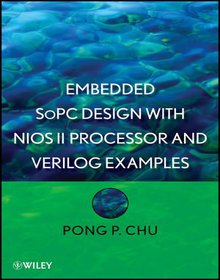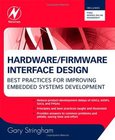Embedded SoPC Design
With Nios II Processor and Verilog Examples

Book Details:
| Publisher: | Wiley |
| Series: | Wiley , Embedded |
| Author: | Pong P. Chu |
| Edition: | 1 |
| ISBN-10: | 1118011031 |
| ISBN-13: | 9781118011034 |
| Pages: | 782 |
| Published: | May 08 2012 |
| Posted: | Nov 19 2014 |
| Language: | English |
| Book format: | |
| Book size: | 34.97 MB |
Book Description:
Explores the unique hardware programmability of FPGA-based embedded systems, using a learn-by-doing approach to introduce the concepts and techniques for embedded SoPC design with VerilogAn SoPC (system on a programmable chip) integrates a processor, memory modules, I/O peripherals, and custom hardware accelerators into a single FPGA (field-programmable gate array) device. In addition to the customized software, customized hardware can be developed and incorporated into the embedded system as wellallowing us to configure the soft-core processor, create tailored I/O interfaces, and develop specialized hardware accelerators for computation-intensive tasks.Utilizing an Altera FPGA prototyping board and its Nios II soft-core processor, Embedded SoPC Design with Nios II Processor and Verilog Examples takes a "learn by doing" approach to illustrate the hardware and software design and development process by including realistic projects that can be implemented and tested on the board. Emphasizing hardware design and integration throughout, the book is divided into four major parts:Part I covers HDL and synthesis of custom hardwarePart II introduces the Nios II processor and provides an overview of embedded software developmentPart III demonstrates the design and development of hardware and software of several complex I/O peripherals, including a PS2 keyboard and mouse, a graphic video controller, an audio codec, and an SD (secure digital) cardPart IV provides several case studies of the integration of hardware accelerators, including a custom GCD (greatest common divisor) circuit, a Mandelbrot set fractal circuit, and an audio synthesizer based on DDFS (direct digital frequency synthesis) methodologyWhile designing and developing an embedded SoPC can be rewarding, the learning can be a long and winding journey. This book shows the trail ahead and guides readers through the initial steps to exploit the full potential of this emerging methodology.
Download Link:
Related Books:
Bootstrap Yourself with Linux-USB Stack
Design, Develop, Debug, and Validate Embedded USB Systems
Learn to design, develop, and validate USB systems with ease, using this valuable resource that provides a detailed bootstrap session on the Linux-USB design and implementation. BOOTSTRAP YOURSELF WITH LINUX-USB STACK offers a tour of the Linux-USB stack, explaining how to develop drivers for USB device and host controllers on Linux. It moves on to explore the interfaces and data structures of a USB module with UML diagrams, concluding each chapter with a sample implementation that applies the information just covered. A comprehensive look at the various tools and methods available on Linux to validate a USB system is also provided. Using a straightforward writing style, this book is a powerful tool for anyone learning to develop a protocol stack wit...
Analog Interfacing to Embedded Microprocessors
Real World Design
Analog Interfacing to Embedded Microprocessors addresses the technologies and methods used in interfacing analog devices to microprocessors, providing in-depth coverage of practical control applications, op amp examples, and much more. A companion to the author's popular Embedded Microprocessor Systems: Real World Design, this new embedded systems book focuses on measurement and control of analog quantities in embedded systems that are required to interface to the real world. At a time when modern electronic systems are increasingly digital, a comprehensive source on interfacing the real world to microprocessors should prove invaluable to embedded systems engineers, students, technicians, and hobbyists. Anyone involved in connecting the analog envir...
Hardware/Firmware Interface Design
Best Practices for Improving Embedded Systems Development
Why care about hardware/firmware interaction? These interfaces are critical, a solid hardware design married with adaptive firmware can access all the capabilities of an application and overcome limitations caused by poor communication. For the first time, a book has come along that will help hardware engineers and firmware engineers work together to mitigate or eliminate problems that occur when hardware and firmware are not optimally compatible. Solving these issues will save time and money, getting products to market sooner to create more revenue.The principles and best practices presented in this book will prove to be a valuable resource for both hardware and firmware engineers. Topics include register layout, interrupts, timing and performance, ...
2007 - 2021 © eBooks-IT.org



